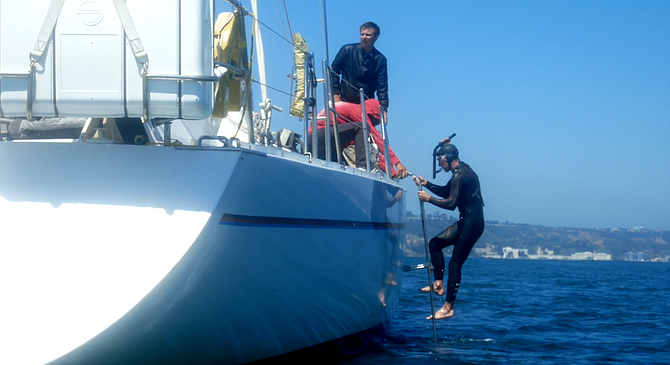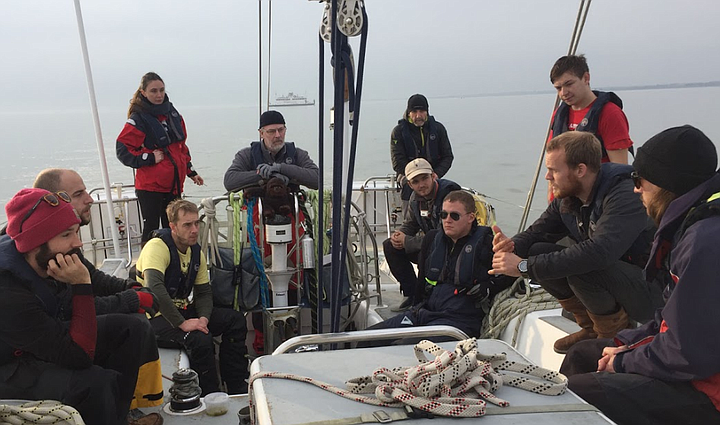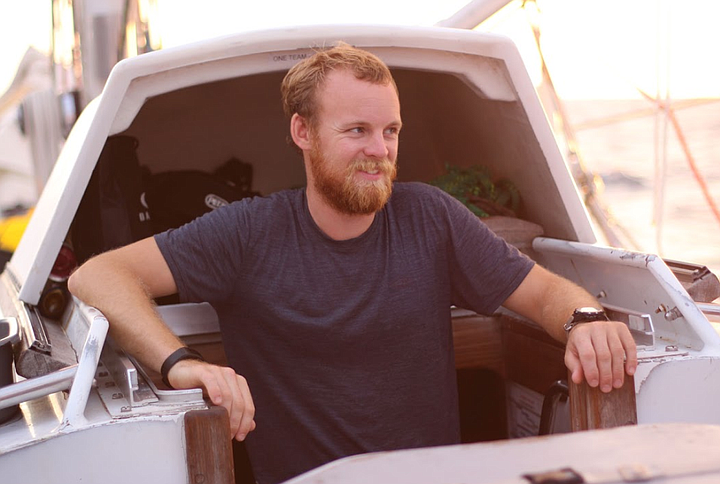 Facebook
Facebook
 X
X
 Instagram
Instagram
 TikTok
TikTok
 Youtube
Youtube

Eight hours per day, 180 days, 5500 miles: that’s the length of the longest swim, to be attempted by Ben Lecomte across the Pacific Ocean from Tokyo to San Francisco. Alongside him will be his 67’ sailboat, the Discoverer, currently anchored at Point Loma marina, and a volunteer crew prepared for the voyage and to conduct citizen science.

If he completes the swim, Lecomte will be the first person to swim across the Pacific, adding to his 1998 swim across the Atlantic. Ben arrived in San Diego in late March to meet the boat, nicknamed Disco, which he bought sight unseen from a seller in the United Kingdom. Scotty the skipper and a skeleton crew sailed her across the Atlantic and through the Panama Canal.

She’ll stay moored at Point Loma for about six months while the boat is refitted with solar, hydro, and wind power-generating systems, satellite communications, and scientific instruments. The team has assembled in San Diego to test the equipment (and their tolerance for each other in close quarters).

The first test: swimming alongside Disco to make sure her wake would not be too rough, which Ben did a few days after arrival. He took his snorkel radio for a dip in San Diego Harbor, testing the device that will be his lifeline. Lecomte will also wear a miniature electrocardiogram recorder, in a water-resistant fabric patch taped to his chest, which will log heart data while he swims.

“We’re asking the question, ‘can too much exercise damage the heart?’” said Anastasia Benjafield, a doctor from the University of London who will be aboard to assist with collecting Ben’s heart data.
Being immersed in water eight hours a day is the closest earthly simulation of the low gravity astronauts experience, so the Universities Space Research Association is looking at Ben’s swim for information on bone density loss and vision loss.
Lecomte and the crew will also take water samples to check cesium levels associated with the 2012 Fukushima Daichi nuclear plant meltdown. More nerve-racking will be the 1,000-mile slog through the Great Pacific Garbage Patch, where the boat will drag a neuston net daily to collect samples of the notorious microplastic detritus. And how about the great white shark migration area? As a precaution, Ben will wear a bracelet that produces an electrical field around the wearer that is supposed to interfere with a shark’s tracking ability.
At a Café de Science event arranged by the Alliance Française de San Diego, Lecomte and the crew showed a Kickstarter promo video they made in San Diego Harbor.
“We are still raising money for food and airtime fees,” the French-born adventurer shared with the audience.
“I have to eat 8,000 calories a day, and possibly leave some for the crew.”
Lecomte hopes to begin the longest swim in spring 2018, when meteorologists advise will be the best “weather window,” avoiding typhoon season in the western Pacific and hurricane season in the eastern.


Eight hours per day, 180 days, 5500 miles: that’s the length of the longest swim, to be attempted by Ben Lecomte across the Pacific Ocean from Tokyo to San Francisco. Alongside him will be his 67’ sailboat, the Discoverer, currently anchored at Point Loma marina, and a volunteer crew prepared for the voyage and to conduct citizen science.

If he completes the swim, Lecomte will be the first person to swim across the Pacific, adding to his 1998 swim across the Atlantic. Ben arrived in San Diego in late March to meet the boat, nicknamed Disco, which he bought sight unseen from a seller in the United Kingdom. Scotty the skipper and a skeleton crew sailed her across the Atlantic and through the Panama Canal.

She’ll stay moored at Point Loma for about six months while the boat is refitted with solar, hydro, and wind power-generating systems, satellite communications, and scientific instruments. The team has assembled in San Diego to test the equipment (and their tolerance for each other in close quarters).

The first test: swimming alongside Disco to make sure her wake would not be too rough, which Ben did a few days after arrival. He took his snorkel radio for a dip in San Diego Harbor, testing the device that will be his lifeline. Lecomte will also wear a miniature electrocardiogram recorder, in a water-resistant fabric patch taped to his chest, which will log heart data while he swims.

“We’re asking the question, ‘can too much exercise damage the heart?’” said Anastasia Benjafield, a doctor from the University of London who will be aboard to assist with collecting Ben’s heart data.
Being immersed in water eight hours a day is the closest earthly simulation of the low gravity astronauts experience, so the Universities Space Research Association is looking at Ben’s swim for information on bone density loss and vision loss.
Lecomte and the crew will also take water samples to check cesium levels associated with the 2012 Fukushima Daichi nuclear plant meltdown. More nerve-racking will be the 1,000-mile slog through the Great Pacific Garbage Patch, where the boat will drag a neuston net daily to collect samples of the notorious microplastic detritus. And how about the great white shark migration area? As a precaution, Ben will wear a bracelet that produces an electrical field around the wearer that is supposed to interfere with a shark’s tracking ability.
At a Café de Science event arranged by the Alliance Française de San Diego, Lecomte and the crew showed a Kickstarter promo video they made in San Diego Harbor.
“We are still raising money for food and airtime fees,” the French-born adventurer shared with the audience.
“I have to eat 8,000 calories a day, and possibly leave some for the crew.”
Lecomte hopes to begin the longest swim in spring 2018, when meteorologists advise will be the best “weather window,” avoiding typhoon season in the western Pacific and hurricane season in the eastern.
Comments